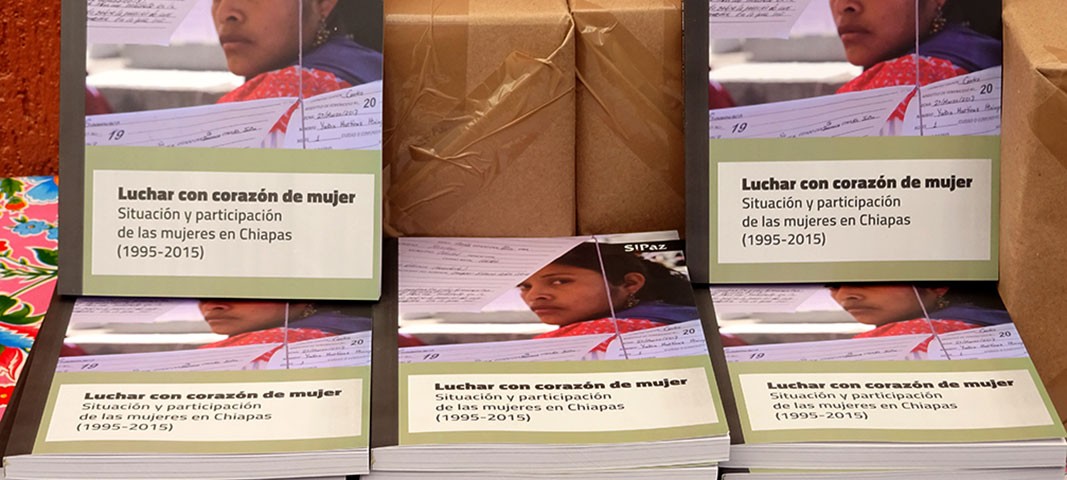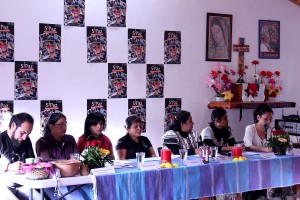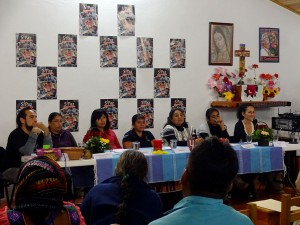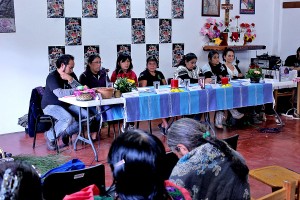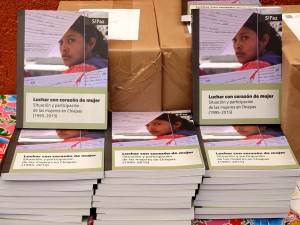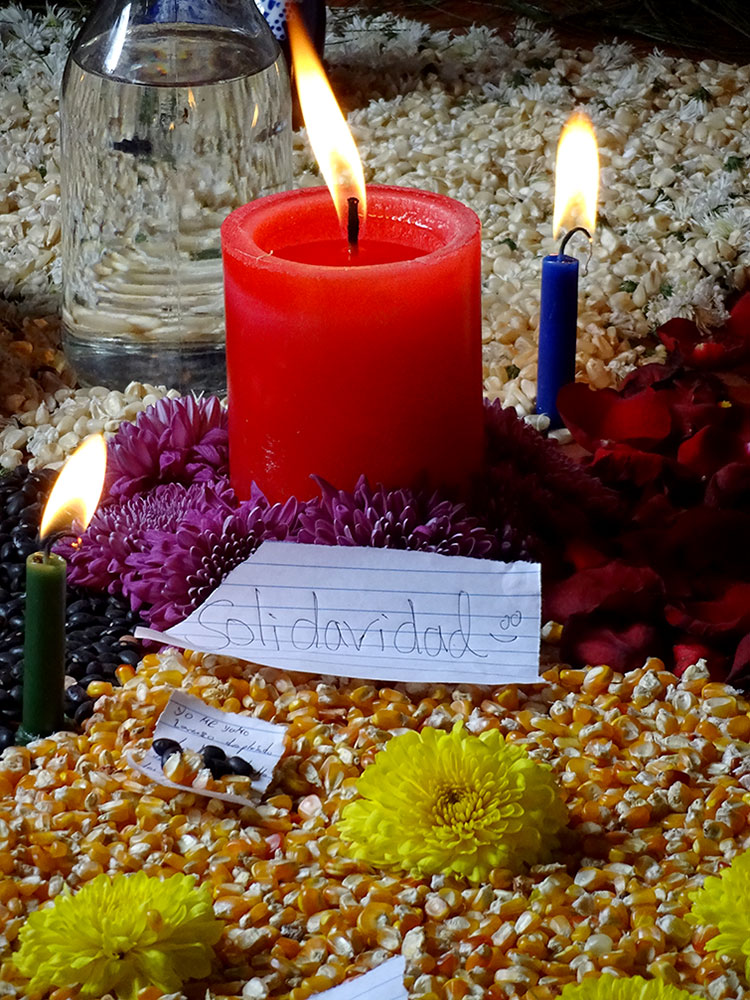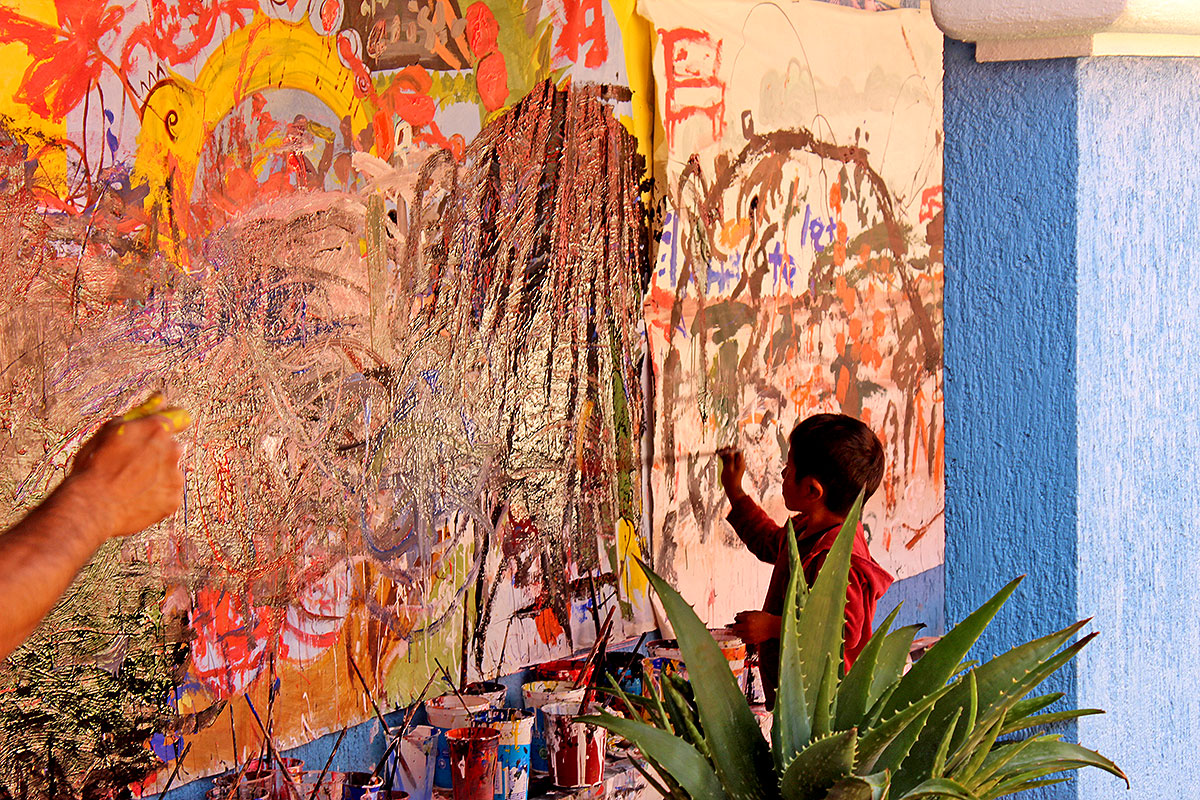
FOCUS: SIPAZ 20 years accompanying Lights of Hope
21/03/2016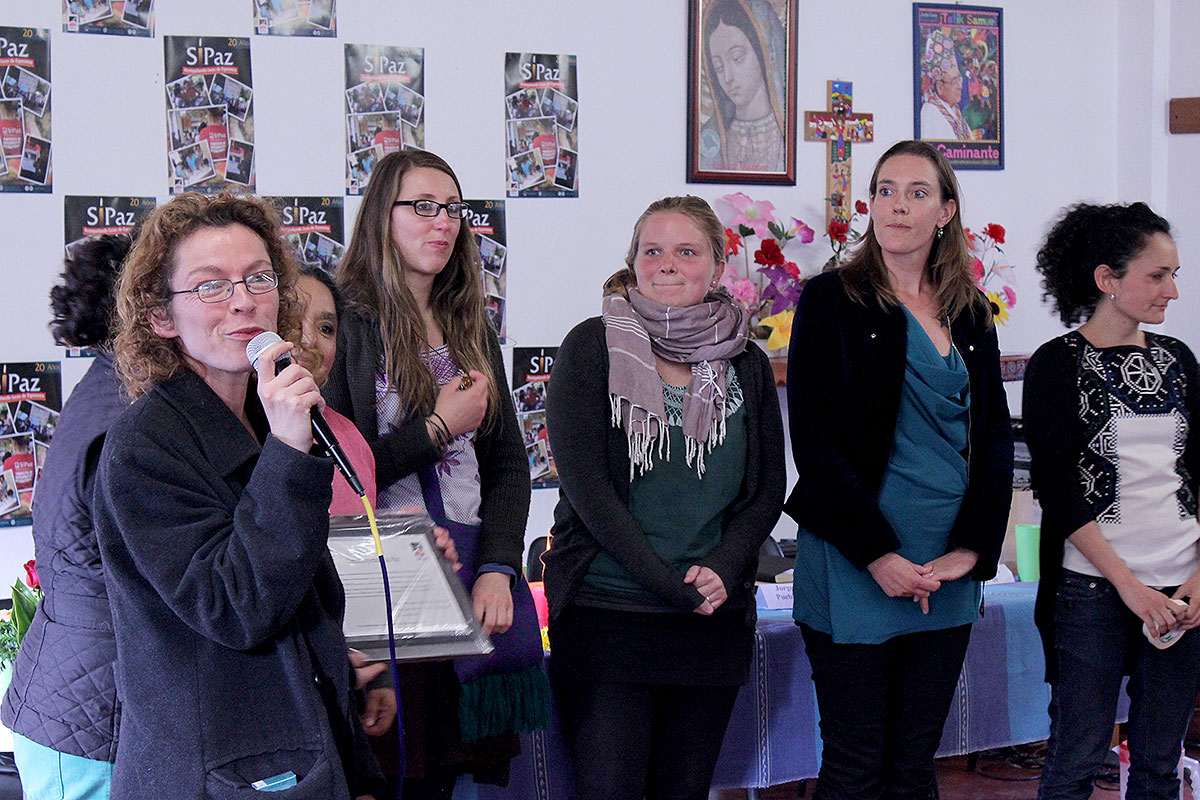
SIPAZ ACTIVITIES (from mid-August to the end of December, 2015)
21/03/2016The twentieth anniversary of the International Service for Peace (SIPAZ) in Mexico marked a great moment to reflect on and compile lessons learned after two decades of accompaniment to organized groups and peoples in the struggle for land and territory, justice, truth, and peace. Conscious of the fact that the most visible roles in organizational processes tend to be occupied by men, we believe it pertinent to elaborate material specifically about the situation of women and their participation in social struggles, avoiding the risk that the part they have played becomes watered down or relegated to second place as it has often happened. “Fighting With the Heart of a Woman ” – The situation and participation of women in Chiapas (1995-2015)”, arose from this, a diagnostic of the main changes of the last twenty years.
We believe that the errors committed,as well as the achievements in the two decades of our path can serve as a reference point for other processes. Based on the lessons learned and on a review of the most notable organizational processes in Chiapas in these twenty years, we would like to provoke “contamination through good example”[1]. That is to say, we want other people, struggles, and resistances to be able to find sources of inspiration in this material; mirrors to see themselves and with which they can reflect and strengthen their path. We do not intend to offer formulae or recipies, but we propose to share our most relevant conclusions in the voice of the same women, protagonists in the processes of struggle of women in Chiapas between 1995 and 2015.
Changes which start from the personal
To elaborate this material, we had the privilege of interviewing over 70 women who, in one form or another , have been involved or are involved with some group, collective, cooperative, social movement, civil association or university. They shared their testimonies with us as women and participants in the organizational processes such as collective or cooperative work; spaces for women’s expression; Zapatista women; women participants in campaigns, marches, pilgrimages and encounters; women members of civil courts; who perform; muralists; and those who carry out gender-work in or from academia.
Most of these began their story denaturing the situation of violence and oppression in which they lived. The expression “it is not my fate” indicates a consciousness, a process, of becomong aware that subordination is not intrinsic to being a woman. “The worst thing is that our situation seemed natural!”. This “awakening” in the face of oppression is too often motivated by living under high levels of violence and pain. There were many life stories full of episodes of physical, psychological and sexual abuse, discrimination, and exploitation in the workplace.
The transformations driven by the women, from their ideological consciousness and affirmation, tend to be deeply internalized: “Real changes come emotionally. Changes of attitude are the ones that allow you to take the next steps.” Even still, the process of change tends to be long and slow, as the women have to go through the deconstruction of that same subordination, deeply rooted after decades of oppression: “Oppression doesn’t only exist in men and in the patriachal structures. It is present in our identities as women. In this sense, we have to distinguish between oppression and subordination. Subordination has to do with all that we have accepted and it is difficult to change.” Many of them said this change was, at the start, terribly solitary, they were rejected by their environment, becoming the object of rumours and gossip.
“Change the way you see things, and those things will change form”
Many of the interviews reflected the view that, once you become aware of your dignity and rights, your way of relating to ohers changes profoundly, beginning with your immediate environment -the family- and little by little, spreading out to the rest of the community. A number said that they lived though sitautions in their families that they never wanted to repeat in their lives: “On seeing my father’s violence to my mother, something I was really sure about was that I didn’t want to go on living like that.” By the same token, these women tend to want a different life for their sons and daughters: “I don’t want the same to happen to you as happened to me.” The increase of self-determination of these women in couples is also noteworthy: “Before, when we got married, it was for life, even though your husband didn’t treat you well after getting married. They told us that it was our cross, that you had to put up with it. That was what our parents taught us. But when one starts to become aware, when one’s eyes are opened, you realize that this is not life, that it dosen’t have to be like that. And if I want a different life, I have to start to fight for a that different life.” Many were of the opinion that the levels of violence that were habitually accepted some years ago are no longer tolerated. In these cases, the tendency is to separate without this being necessarily seen as something negative as was systematically the case two decades ago.
Men and women struggling together
Another aspect that many women noted is the importance of the collective in feeling strong and being able to fight to have their rights fulfilled: “When we participate and meet with other women, our heart feels strong; if there is no organization, if there is no discussion, our eyes feel closed.”[footnote 3] Although they may not necessarily be aware of it, the changes within themselves have sptread out and have transformed the very social order. Furthermore, these women have become aware that “without participation it is impossible to win the struggle, today they know they are necessary and they fight for that so that their work doesn’t become underestimated or ignored again.”[footnote 4] Some highlighted the importance of having work groups exclusively for women at the outset “so that first we learn to participate in spaces where there is no oppression on the part of men and then we encourage ourselves to participate in mixed spaces once we have more confidence in ourselves.” Yet the majority stressed that “it is not a struggle against men”, but that they see the necessity for the participation of men as well as women, recognizing that “the transformation of relations has to be on both sides”, as “in the struggle we can’t walk on just one foot” or “We already know but who is going to tell the authorities that we have rights?”
This idea of men and women walking together is one of the notable characteristics of the struggle for gender equality in the Zapatista movement, which has had at the center of its demands the fulfillment of the rights of indigenous Zapatistas since its beginnings. This process, one of the most outstanding in regards to advances in “gender justice”,[footnote 5] began publically at the end of 1993 with the publication of the Women’s Revolutionary Law, an innovative document which compiled the ten demands of the Zapatista women such as the right to participation, to work and a salary, to decide how many children they can have and care for, to hold position, to health and food, to education, to choose their partner, not to be beaten, and to have equality of rights and duties contained in the revolutionary laws.
Another aspect that was observed is that the women’s groups, whose center is not a political ideology or a political party, have maitained more diversity in their members. An Example is the Women’s Diocesan Coordination (CODIMUJ), a space for meeting, reflection, and collective transformation for the rights of women and it has the participation of between seven and ten thousand of the parishes of the diocese of San Cristobal de Las Casas, who interpret the Bible “with the eyes, mind, and heart of a woman.” With a history of more than 30 years, they seek gender equality from the word of God, the perspective of gender, and liberation theology independently of any political party or organization affiliation.
Lessons learned from the good and the bad
A characteristic of the majority of the organizational experiences of women in Chiapas has been their practical aspect, rahter than being abstract or theoretical: “You have to do to learn.” They also put particular emphasis on the importance of coherence: one interviewed woman underlined the fact that although it takes more time, “the form has a basis”, refering to the importance of taking care of all the parts of the process as they all have an effect on the final objective.
The organizational processes have faced various difficulties, among those the high level of rotation of the participants, often due to the fact that “the men are against it’ and there are disqualifications among the same women. Therefore, the search for new forms of leaderless and horizontal participation have been identified as an aim as “there are power struggles between women too. We can be more conflictive” or ‘we don’t see beyond the process. A long transformation is the bet. In the face of protagonisms, we need to question the oppressor within us.” On the same note, one interviewed woman stated, “The danger is coming to have a masculinized equality. This is the western model, which has focused on the economic independence of women. (…) This limits you to having the same discourse as men. (…) Why do we make ourselves seem stronger, harder and louder? A woman form CODIMUJ says that the important thing is to learn to fight with the heart of a woman” (hence the title of the book).
Many of the testimonies colleted had criticisms and self-criticisms of the work of non-government organizations (NGOs) that worked or work with women in Chiapas. One of the most common is the ideological conflicts between indigenous communities and hegemonic feminism, which doesn’t accept the idea of complementariness between men and women, special to Maya cosmovision. Also notable are the differences between the ways of relationship between indigenous women from rural backgrounds and those of urban and mestizo women. In the same vein, they do not have the same priorities and agendas, such as demands in relation to their bodies, sexual and reproductive rights, volutary termination of preganacy, pleasure, economic independence of women as regards men, or the fact that postures centered on the individual predominate, while in indigenous and rural contexts the logic of the community has prevailed. Coupled with this, some organizations realised that they were creating dependency: “We learned to be more careful, to not decide for [the women]”, and they also redirected their work toward the strenghtening of women beneficiaries to develop their autonomy.
Women making themselves “subjects of social change”
One of the most notable achievements of the struggles of these 20 years is that a great number of women “discovered themselves as political subjects.” This occurs from an understanding of reality from their own viewpoint, affirming that “they can take their life in their own hands; they don’t want the paternalistic protection of those who ‘know better.’ […] Through their revindications they show the falsity of all dominant stereotypes and they are driving a different conception of indigenous peoples and especially of women. The indigenous peoples are no longer backward, indigenous mothers are no longer the poorest, most passive, with many children, but women – and even mothers – in struggle; indigenous women are strongly attacking the image of passivity and backwardness with the aim of definitively destroying it.” This rise of women as subjects of change happened because of the awareness of the structural violence which they suffer, with examples such as “We are not poor because God wants it” or “there are no poor women, there are impoverished women.” In this sense, the women reflect that “there cannot be a transformation in gender relations if the system is not transformed, the conditions of life” and, in consequence, actions in search of equity have been directed at different levels, from the individual to the structural.
A tendency that has caused “divisions, disillusion and wearing down” in the processes has been the cooptation of women leaders of social movements by government organisms. As one women said, “The patriarchy is seeing how to appropriate women to perfect itself. There is a tendency to cooptation and recruitment of women which serves to strengthen the system.” Many of those interviewed joined government bodies at some point in their lives. Some see it as a form of “incidence in public politics’, but the majority of them conclude that “there were many grids and a total lack of sensitivity on the part of the officials”, “I learned that you cannot make the revolution from within the state” or “The institutions reproduce the violence that they intend to contest. They see to cases but they will never stop. Nothing is solved in depth.”
It’s not surprising, therefore, that one of the common opinions of the women interviewed is the little faith they have in government authorities for the achievement of equity between men and women. A wide discrediting regarding the application of laws for the protection of women was noted: “What good is a law to us if there are no changes?”; or regarding government programs – such as Oportunidades, Prospera, Progresa, Madres Solteras, Nuevo Amanecer, etc. (Opportunities, Prosper, Progress, Single Mothers, New Dawn, etc.) – which give monetary support as aid, a source of dependency and servility of women which maintain “a logic of fast answers but not of prevention.” It is worth noting that the women who receive these programs must agree to imposed preconditions if they wish to continue receiving them, such as regular attendance at training courses or health checks. In the words of one woman interviewed, “Now I am like a government prostitute because in exchange for the money that it gives me, I let doctors touch up my body.” Likewise, a number of women highlighted that “rather than supporting indigenous people, the government is only dividing them through political parties and programs.” Facts were also witnessed which “worsened the problems instead of reducing them”, such as reports of violence, which are not followed through on by public officials.
In spite of the increase in political and organizational participation of so many women, the majority of them have not espressed themselves or organized to combat the discrimination that they live and this implies a challenge because we are facing a “struggle of women which is not assumed to be a struggle of all women.” Even so, as we have seen, women represent a large group of beacons of hope, from which, if there are possibilities of change, “more women will come. Men are not going to take the plunge because they run the risk of losing their privileges. Women have nothing to lose.”
After this little “taste” of the main learnings collected by women participants in the organizational processes in Chiapas from 1995 to the present, we invite all readers who wish to continue deepening their knowledge about the struggles of women and their most outstanding expressions to read “Luchar con corazón de mujer. Situación y participación de las mujeres en Chiapas (1995-2015)”. You can download the digital version on our website. Thanking all the struggling women of Chiapas, Mexico and the world for being an example of strength and organization, we urge you to read this book, to evaluate it, to work on it, to spread it…but, above all, to understand it as an interpellation to reflect and act.
Notas:
[1] Unless shown to the contrary, all quotes in this Focus come from the interviews carried out for the elaboration of this book. (^^)

